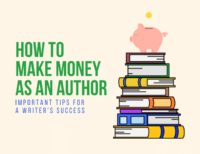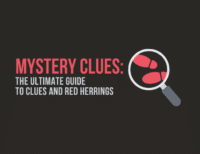In real life, some folks love surprises and others hate them. But one thing is certain—in fiction, you need them to write a book readers can't put down. One way to deliver is through a narrative hook. But what is a narrative hook and how can you write a hook to captivate readers?

The purpose of a narrative hook is to pull your reader through to the next page, paragraph, or sentence where you’ll have planted another hook to keep him going.
In this article, we’ll answer what is a narrative hook and look at how to write hooks that present surprising situations or something unexpected to rivet reader attention.
What is a hook?
A narrative hook is the element of your story that grabs the attention of your reader and makes them want to keep reading. It’s often an unexpected situation or character, but it can also be a surprise twist or a cliffhanger.
Think of it like a fishing line with a tantalizing bait—once you’ve got your reader hooked, they won’t be able to help themselves but keep reading.
Why do you need a strong hook?
In her fabulous book Wired for Story, Lisa Cron tells a personal story about a manuscript she read that was boring and difficult to get through but had an exciting twist at the end. The writer was afraid he’d give away the surprise and wanted to hide all traces of the ending until it was time to spring it.
The trouble was, there was nothing to pull readers through to the thrilling conclusion. As writers, we know when we have something sensational up our sleeve for our story idea.
But if we don’t let readers know about it, they won’t keep turning pages to find out what it is.
So how can we do that and still surprise them?
Instead of keeping readers in the dark, think misdirection. Like an illusionist who draws attention to one hand while concealing or maneuvering with the other. And using hooks is one way of drawing that attention.
Choose the type of hook
You can craft an effective hook that is a surprise to the character, a surprise to the reader, or both.
When the reader knows more than the character does, it creates dramatic irony, a delicious brand of suspense. As readers, we look forward to the revelation that will surprise the character.
Recently, I came across an example of a fun hook that was a surprise to me, as reader, but didn’t faze the character. In Lee Child’s short story James Penney’s New Identity, the title character is on the run from authorities after setting a fire that raged out of control.
Toward the end of the story, he is picked up by a motorist who introduces himself as Jack Reacher! Suddenly my attention is riveted by surprise. I know the character Jack, but didn’t expect to see him here. Why is he in this story? How is he involved in the whole mess?
Using a character from another book created a hook that kept me reading.
Use the right bait
Remember, reader expectation is key. Always write to your core audience and bait your hook appropriately.
For instance, I write mysteries and thrillers so my target readers will expect elements of danger, death, crime, sorrow, and vengeance to come into play. This bait won’t necessarily attract a reader of sweet romance or hard science fiction. The best way to know what your readers expect is to read a lot of books in the genre you plan to write in.
And don’t forget, you should be threading multiple hooks through the scenes and sentences of your story, according to the taste and expectations of your ideal reader, as I discussed in my article on writing danger hooks.
6 Hook Writing Tips to Surprise the Reader
Now that you know the surprise can be for either the character, the reader, or both and that you should use the right bait, let’s take a look at six techniques for how to write a hook that surprises your reader.
1. Question
Remember how we looked at baiting a story hook with questions in an earlier article? When crafting a surprising situation hook, it has to be more than an ordinary question. It has to be—what the !?!?!
Essentially, you're planting questions that the reader wants to have answered so much that they turn the page.
2. Contrast
Your narrative leads your reader’s expectations. Instead of showing them what they anticipate seeing, reveal something entirely unexpected instead. This is that magician’s trick of misdirection we talked about earlier.
Just remember to stay true to your story conflict and story goal. Don’t tack something on just for effect—it must grow organically from the seeds of your entire story.
To write a contrast hook, write out what the reader expects and then play with the exact opposite. How can you incorporate that contrast?
3. Work up to the punchline
If you read my article on using humor in your writing, you’ll know that surprise acts in much the same way. Start out with a sentence that delivers the “normal,” layering in detail and leading your reader down a path to the punchline where you deliver the surprise.
Using a suspensive sentence structure (also known as the periodic) is great for this. This type of sentence saves the main clause for last, keeping your reader guessing as to where it will all end. It’s also an example of the classic setup and payoff.
4. Don’t bury the hook
In order to be effective, the hook should stand alone or be placed either at the beginning of the sentence/paragraph or at the end. Placement is important. Burying it in the middle will blunt the hook and your reader will miss it.
5. Alter a cliché
As writers, we’re taught to avoid clichés. But you can actually make a worn-out clause work in your favor if you use it to set up reader expectation and then twist it with a surprise.
6. Use a surprise hook at the end of a chapter
Most readers pick up a book at bedtime, planning to get a chapter in before turning out the light. If you throw in a surprise hook as your reader is reaching for the light switch, you may be able to pull them into the next chapter, where you’ll have a series of new hooks waiting.
Let’s take a look at some story hook examples
“There was a desert wind blowing that night. It was one of those hot dry Santa Anas that come down through the mountain passes and curl your hair and make your nerves jump and your skin itch. On nights like that every booze party ends in a fight. Meek little wives feel the edge of the carving knife and study their husbands’ necks. Anything can happen. You can even get a full glass of beer at a cocktail lounge.” Red Wind, Raymond Chandler
This is one of my all-time favorite story openers, and it’s a good example of leading readers down a path, setting up expectations, and then throwing a curve right at the end. Here’s another in that same vein:
“High, high above the North Pole, on the first day of 1969, two professors of English Literature approached each other at a combined velocity of 1200 miles per hour.” Changing Places, David Lodge
And look at these beauties:
“Every summer Lin Kong returned to Goose Village to divorce his wife, Shuyu.” Waiting, Ha Jin
“I write this sitting in the kitchen sink.” I Capture the Castle, Dodie Smith
“As Gregor Samsa awoke one morning from uneasy dreams he found himself transformed in his bed into an enormous insect.” The Metamorphosis, Franz Kafka
These three are superb examples of sharp, clear standalone hooks that pose such a strong and compelling question that it constitutes surprise.
How to craft a surprise story hook
Remember, you don’t have to whip these out during your first draft. The revision process is the perfect time to look for opportunities to strengthen your writing with hooks. Let’s pretend this is my first draft:
A shadow loomed out of the darkness and Rick hit the brake, finding himself surrounded by llamas.
This is the end of chapter 58, and occurs after a drive through a distressed forest area near Seattle where Rick earlier had a near-miss with a deer in the road. So, while the herd of llamas is certainly an unexpected event, it lacks the punch it might have with some revision. Let me try again.
Another deer loomed out of the darkness, or so Rick believed. To his surprise, it was a llama and there were more of them.
Okay, so now I’m tipping my hat to surprise, telling my reader that Rick expected to see another deer and was startled to see the llamas. But instead of telling, why don’t I try getting inside Rick’s head so the reader can experience his dismay as it progresses from caution to creeped-out to incredulity? Here’s the published version:
“Another deer loomed out of the darkness and Rick nudged the brake, slowing to a crawl. It wasn’t a deer, and it wasn’t alone. A veritable herd of creatures swarmed him, forcing the car to a halt, creating a barrier between him and the house. He’d been captured by a phalanx of llamas.” Nocturne In Ashes, Joslyn Chase
A toolbox full of hooks
Are you having fun adding some hooks to your writer’s toolbox? If you want to learn more about how to write a hook, Mary Buckham has several books on the subject that are very instructive.
Remember to use a combination of hooks as a fail-safe system in case some of your hooks don't work, and always tailor your hooks to your core audience. So go bait your hooks, cast out your line, and catch your ideal reader!
How about you? Do you like surprises in real life? In fiction? Do you see the value in a surprise hook? Tell us about it in the comments.
PRACTICE
Let’s work on crafting a surprise hook. Choose one of the scenarios below and write a “first draft” straightforward opening sentence. Then revise, using the techniques discussed in the article, until you have a focused and powerful surprise hook. Show your progression and have fun!
Martha gets a letter from her foreign pen pal that shows he’s not who she thought he was.
Darren takes the bags of groceries into the kitchen to put them away and finds something totally unexpected in one of the bags.
After using the restroom aboard a trans-Atlantic flight, Jenny takes the wrong seat by mistake and overhears something she never thought she’d hear.
Write, revise, and craft your hooks for fifteen minutes, then post your work in the Pro Practice Workshop here. Be sure to provide feedback for your fellow writers! Not a member?
Come join us here and practice writing hooks and other story skills.,







0 Comments
Trackbacks/Pingbacks